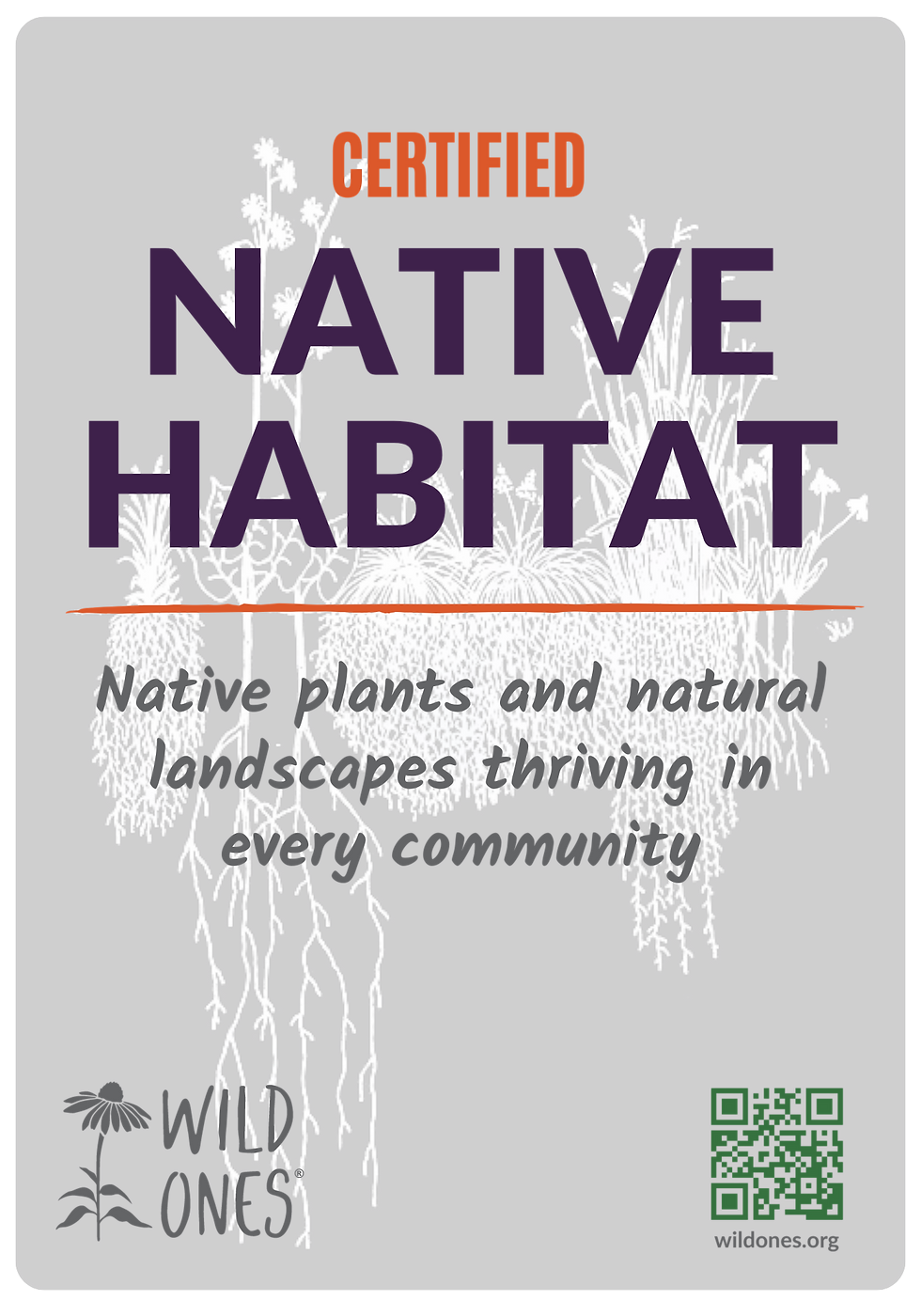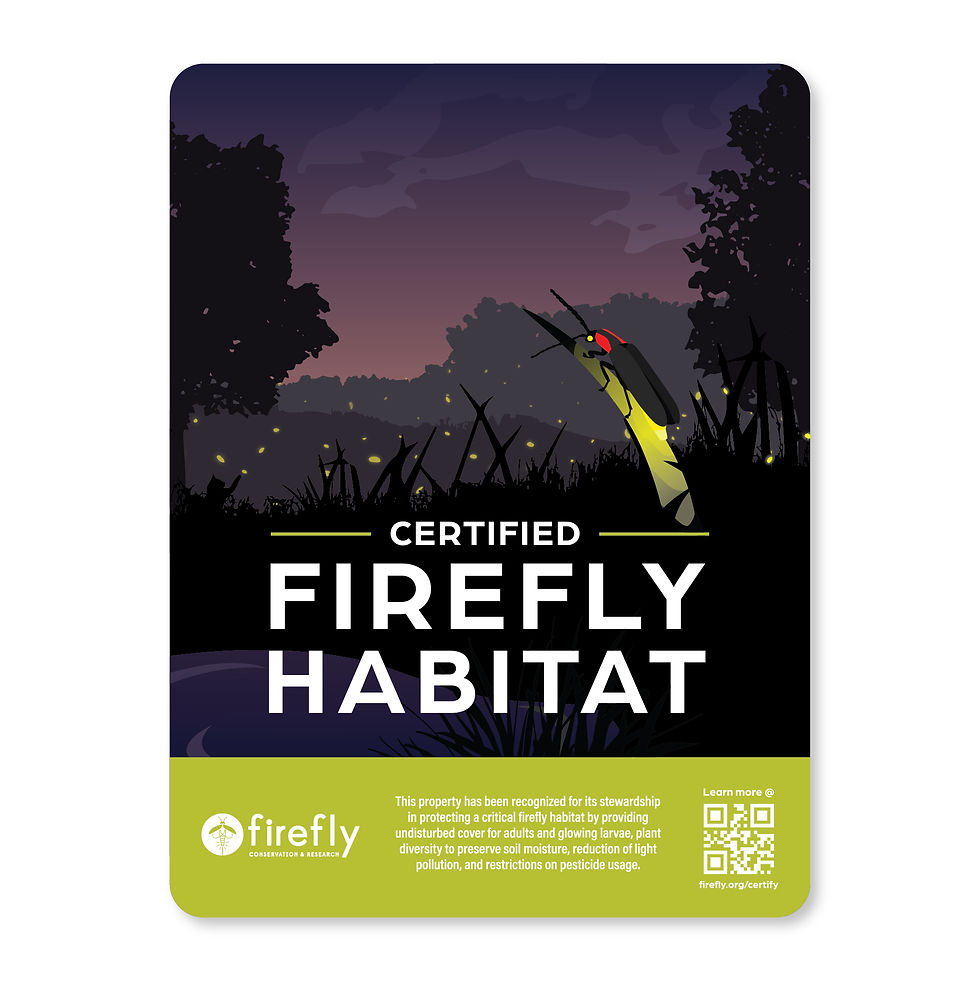There's a Certification (or Sign) For Every Kind of Eco-Friendly Yard
- ljmarkson

- Feb 23, 2021
- 7 min read
Updated: Jul 16, 2025
Whether you consider your yard a pollinator habitat, native plant habitat, wildlife sanctuary, wildlife habitat, green landscape, native plant butterfly garden, or even a monarch way station there’s a certification for it! In my last post I suggested the many reason to consider getting your yard certified and posting a sign to help normalize naturalized landscapes. Hopefully, the following information will help you decide which organization best aligns with the message you want to share with your neighbors and community. Don't feel the need to stop at one though!

I’ve included an overview of certification requirements from Georgia organizations and made a list of some national organizations you can self-certify through from any state. Scroll away and click the highlighted links for more details. Please share to spread awareness.
Georgia Organizations
Trees Atlanta’s City Forest Certification is the newest and most accessible yard certification in metro Atlanta. This hands-on community action focused program is designed to guide and empower everyone from apartment dwellers to homeowners to meet the goals of certification. The certification process includes access to extensive education resources. A one-time donation of $65 covers the program administration, resources, and signage but is not required to participate.

The Georgia Native Plant Society (GNPS) Native Plant Habitat certification requires a site visit and for you to remove all invasive plants from the category 1 and 2 lists on the Georgia Exotic Pest Council. This is a change-driven certification because popular traditional landscape plants still sold at nurseries in Georgia are on this list including English ivy (hedera helix), sacred bamboo (nandina domestica), big or common periwinkle (vinca major or minor), Chinese or Japanese privet (ligustrum), and Chinese wisteria (wisteria sinensis). It was affirming to have my yard profile added to the GNPS album (you can see mine by clicking here). Both Silver and Gold certification require a percentage of your yard include native plants in four different categories (trees, shrubs, ferns, grasses, perennials, annuals, vines, mosses/lichens, water/bog plants) and that 5 out of 10 sustainable gardening practices are followed (support wildlife, compost, avoid herbicides and pesticides, capture and use rainwater, use soaker hoses, minimize lawn areas, mulch, or leave the leaves, reduce use of fossil-fuel-powered lawn equipment). The difference in the levels depends on what percentage of your yard is landscaped with native plants. The certification is $30 and includes a yard sign plus you need to be a member of the GNPS ($30 for an individual).

Birds Georgia's (previously Georgia Audubon Society) Wildlife Sanctuary Program certification was the most rewarding certification for me personally because my property was chosen as one of only a handful of certified properties for the 2019 Atlanta Audubon Sanctuary Tour. I was told that although it was the smallest property on the tour it showed that even a small urban yard can become a wildlife sanctuary. You can pick an area of your yard to be certified but the area must be at least 50 square feet, the lawn less than half of the area, half the plants in the area need to be native to Georgia, and surprisingly ¼ of the area can include invasive or non-native plants as long as they aren't intentionally cared for (this is probably geared towards certifying large parks where invasive plants are a challenge to remove completely). In addition, two listed plant layers are required (ground grasses or forbs, shrubs, mid-story trees, canopy trees), outdoor cats can’t be fed or maintained, basic wildlife components are needed (4 food sources, water source, 4 cover and nesting shelters), and safe wildlife practices need to be in place (minimal outdoor lighting, bird-collision prevention features, no pesticides, and limited use of leaf blowers). Once you feel you meet the requirements you can schedule a site visit and once certified you will get a sign and be added to a list of over 600 certified properties in Georgia. The certification fee for property less than 3 acres is $75 for private residences and $100 for commercial/public property/school and includes a yard sign plus you need to be a Bird's Georgia membership ($35 for an individual).

Georgia Green Landscape Steward certification from UGA Cooperative Extension has a helpful and detailed educational component of available power point presentations and videos. Once you review the educational components in 10 categories (composting, invasive plants, mulching, biodiversity, water quality, stormwater management, water conservation, welcoming wildlife and pollinators, native plants) to see what metrics you’ve met, and possibly implement additional sustainable landscape practice projects, you fill out a scorecard. The minimum number of points necessary to meet certification requirements is not difficult if you are already following sustainable landscape practices. My score was more than double the requirement, but my yard is already certified by multiple other organizations! If you’re a newbie to sustainable landscape practices, this certification is a good template to help you create a healthier ecosystem in your yard. There is no fee for the certification and if you want a yard sign the fee is $15.00.

The Pollinator Habitat certification from Environmental Education of Georgia’s Monarchs Across Georgia program requires growing at least two milkweed species, hosting plants for five butterfly species, four nectar sources in each of three seasons, having a butterfly habitat (water source, basking site, shelter), spaces for native bees to raise young, and following nine conservation practices (including composting, mulching, avoiding herbicides, pesticides and fertilizers, using drip soakers, using native plants, xeriscaping, reducing or eliminating lawn) The process involves completing and getting an application approved to see if any changes are needed before officially applying through an online application, making payment, and sending photos of your garden. Certifying your habitat is $15 for a certificate or $40 for a certificate and a yard sign.

Local Chapters of National Organizations
Check your local or state Audubon chapter to see if they have a Wildlife Sanctuary Program
Check your local or state Native Plant Society to see if they have a yard certification program
National Organizations The National Wildlife Foundation has an online application to designate your yard a Certified Wildlife Habitat. To get this popular certification and yard sign there is a checklist confirming several elements in the categories of food, water, cover, places to raise young, and sustainable practices. For a $20 application fee you receive a certificate, one year membership in the National Wildlife Federation, a National Wildlife magazine subscription, a discount on NWF merch, and the opportunity to purchase a yard sign for an additional fee.

Wild Ones has a Native Habitat certification for members working towards a goal of at least 75% native plant species in their gardens. Additional requirements include not using pesticides and herbicides, removing invasive plants, providing pollinator and wildlife habitat, and adding your plant lists in the application. The certification cost is $50 and includes a yard sign that signifies your commitment to supporting native habitats.

To register your yard as a certified Monarch Waystation through Monarch Watch you need to complete an online certification application. The cost for both the application and sign is $36

The North American Butterfly Association Butterfly Garden certification requires 3 host plants and 3 nectar sources. They encourage but don’t require native plants (what a missed educational opportunity!) and pesticides are discouraged. Certification application is $15, and signs are $25 each once your garden is certified

The Xerces Society has more of a pledge program than a certification process. You must promise to 1) Grow a variety of bee-friendly flowers that bloom from spring through fall 2) Protect and provide bee nests and caterpillar host plants 3) Avoid using pesticides, especially insecticides. 4) Talk to neighbors about the importance of pollinators and their habitat. The Pollinator Habitat pledge sign is one of my favorites because it has the tagline Planted for Pollinators, Protected from Pesticides. The sign is a pricey $66 but it's also one of the most inviting and it supports a worthwhile organization.

Firefly Conservation and Research has a yard certification with a sign you can get for $45. A downloadable certification guide will help complete the necessary steps to certify the habitat. The following elements on your land are needed:
Providing undisturbed cover for adults and glowing larvae
Encouraging plant diversity to preserve soil moisture
Reducing Light Pollution
Restricting Pesticide Usage

The Firefly Habitat sing is always a conversation starter!
Homegrown National Park is a grassroots call-to-action to start a new habitat by adding native plants and removing invasive ones. You can add your name to an interactive biodiversity map connecting habitats around the country to create a national homegrown national park. You can purchase a Homegrown National Park yard sign or download a template and have it printed with your name and organization. There's even a kid's version to display to include the generation that is going to bear the brunt of the biodiversity crisis.

Note: There are no affiliate links in this blog. Please click the highlighted text throughout the posts for links to references, details, explanations, worthy organizations or businesses, or examples that I think might be helpful.


.jpg)
